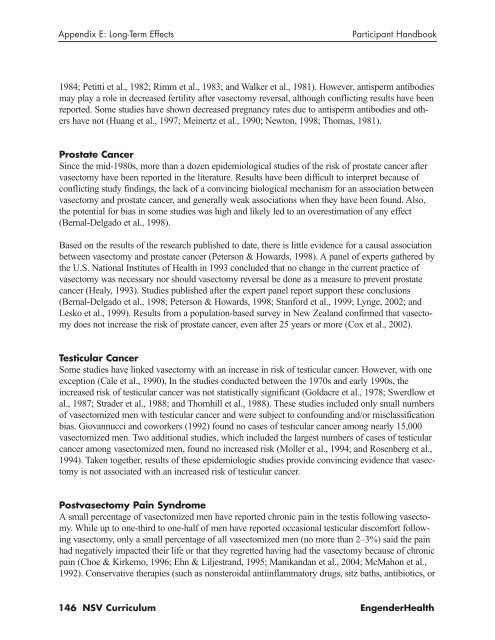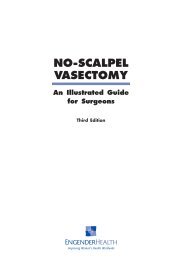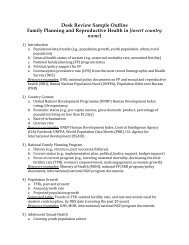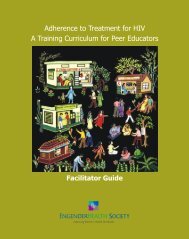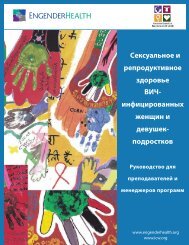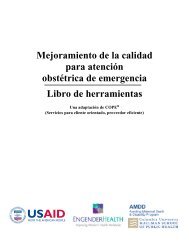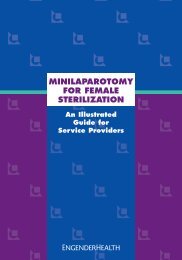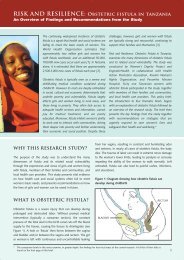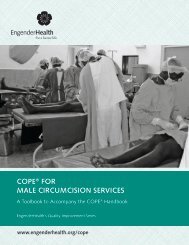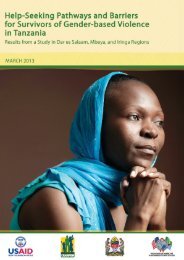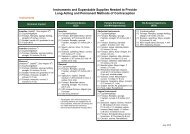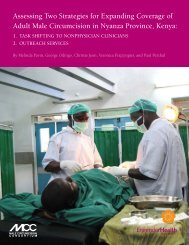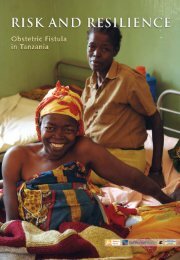NO-SCALPEL VASECTOMY - EngenderHealth
NO-SCALPEL VASECTOMY - EngenderHealth
NO-SCALPEL VASECTOMY - EngenderHealth
You also want an ePaper? Increase the reach of your titles
YUMPU automatically turns print PDFs into web optimized ePapers that Google loves.
Appendix E: Long-Term Effects Participant Handbook<br />
1984; Petitti et al., 1982; Rimm et al., 1983; and Walker et al., 1981). However, antisperm antibodies<br />
may play a role in decreased fertility after vasectomy reversal, although conflicting results have been<br />
reported. Some studies have shown decreased pregnancy rates due to antisperm antibodies and others<br />
have not (Huang et al., 1997; Meinertz et al., 1990; Newton, 1998; Thomas, 1981).<br />
Prostate Cancer<br />
Since the mid-1980s, more than a dozen epidemiological studies of the risk of prostate cancer after<br />
vasectomy have been reported in the literature. Results have been difficult to interpret because of<br />
conflicting study findings, the lack of a convincing biological mechanism for an association between<br />
vasectomy and prostate cancer, and generally weak associations when they have been found. Also,<br />
the potential for bias in some studies was high and likely led to an overestimation of any effect<br />
(Bernal-Delgado et al., 1998).<br />
Based on the results of the research published to date, there is little evidence for a causal association<br />
between vasectomy and prostate cancer (Peterson & Howards, 1998). A panel of experts gathered by<br />
the U.S. National Institutes of Health in 1993 concluded that no change in the current practice of<br />
vasectomy was necessary nor should vasectomy reversal be done as a measure to prevent prostate<br />
cancer (Healy, 1993). Studies published after the expert panel report support these conclusions<br />
(Bernal-Delgado et al., 1998; Peterson & Howards, 1998; Stanford et al., 1999; Lynge, 2002; and<br />
Lesko et al., 1999). Results from a population-based survey in New Zealand confirmed that vasectomy<br />
does not increase the risk of prostate cancer, even after 25 years or more (Cox et al., 2002).<br />
Testicular Cancer<br />
Some studies have linked vasectomy with an increase in risk of testicular cancer. However, with one<br />
exception (Cale et al., 1990), In the studies conducted between the 1970s and early 1990s, the<br />
increased risk of testicular cancer was not statistically significant (Goldacre et al., 1978; Swerdlow et<br />
al., 1987; Strader et al., 1988; and Thornhill et al., 1988). These studies included only small numbers<br />
of vasectomized men with testicular cancer and were subject to confounding and/or misclassification<br />
bias. Giovannucci and coworkers (1992) found no cases of testicular cancer among nearly 15,000<br />
vasectomized men. Two additional studies, which included the largest numbers of cases of testicular<br />
cancer among vasectomized men, found no increased risk (Moller et al., 1994; and Rosenberg et al.,<br />
1994). Taken together, results of these epidemiologic studies provide convincing evidence that vasectomy<br />
is not associated with an increased risk of testicular cancer.<br />
Postvasectomy Pain Syndrome<br />
A small percentage of vasectomized men have reported chronic pain in the testis following vasectomy.<br />
While up to one-third to one-half of men have reported occasional testicular discomfort following<br />
vasectomy, only a small percentage of all vasectomized men (no more than 2–3%) said the pain<br />
had negatively impacted their life or that they regretted having had the vasectomy because of chronic<br />
pain (Choe & Kirkemo, 1996; Ehn & Liljestrand, 1995; Manikandan et al., 2004; McMahon et al.,<br />
1992). Conservative therapies (such as nonsteroidal antiinflammatory drugs, sitz baths, antibiotics, or<br />
146 NSV Curriculum <strong>EngenderHealth</strong>


